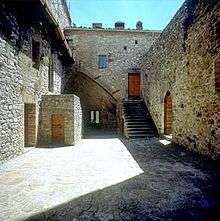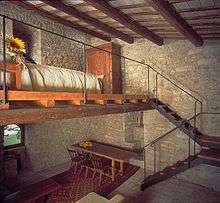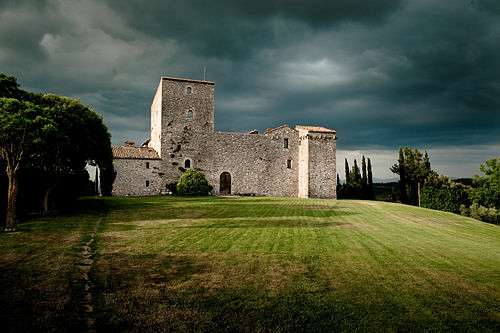TodiCastle - True Umbria
| TodiCastle | |
|---|---|
|
Aerial view of the TodiCastle | |
| Location | Umbria, Italy |
| Coordinates | 42°28′12″N 12°15′00″E / 42.4700°N 12.2500°E |
| Elevation | 580m |
| Built | 1100 AD |
| Architect | Marcello Confetti, Giorgio Leoni and Vittorio Garatti |
| Architectural style(s) | Italian |
| Type | Cultural |
| State Party |
|
 Location in Todi, Italy | |
TodiCastle is part of the True Umbria Estate and is a located c. 15 km south of the town of Todi, on a hilltop to the east side of the town of Collelungo, which is part of the Municipality of Baschi, near Terni, in Umbria, Italy.[1] The Castle is surrounded by a large estate that includes several other Historical buildings, including some villas.
History
TodiCastle was built during Roman times, in order to protect the Colonia Julia Fida Tuder (Todi Roman name) for the southern boundary line. Torre d'Orlando (former name of the watch tower) was built in a strategic position, to look over the area bounded by the river Tiber, the river Arnata and a famous Roman road, the Via Amerina, which linked Todi to Lazio. Its strategic function continued into the Middle Ages. When Desiderius, the last king of the Lombard realm, reigned over Italy. The territory of the Julia colony was granted to the Pope; five hundred years later, in 1275, it became the Diocese of Todi and then the Municipality of Todi.[2][3]
Several additional towers were built from the 10-13th centuries and the original tower was incorporated into a now larger fort or Rocca. There were three towers in the corners and a large bastion wall to protect the wide territory. Todi flourished in the 13th century.[2]
The food for the animals and the soldiers were stored in very large quantities within the castle and the rain water was collected for drinking. The soldiers lived in the towers and the animals were kept in the open areas. The castle was the key point for all the Northern European pilgrims that used to travel to Rome and soon enough the area became quite wealthy due to commerce and trade. In 1348 the Black Plague struck and later in the mid-14th century the municipality of Todi collapsed.[2]
In the later years, TodiCastle even after the bubonic plague decimated the local countryside. The castle was also abandoned by the warriors and soldiers and then used by the wanderers. During 15th century, the castle was turned into a monastery. A roof was constructed in the courtyard and the space was transformed into a church dedicated to Saints Julietta and Quiricus.[2]
Later, in the 17th century, the monastery was also abandoned and the castle became the object of dispute among several local lords. Lastly, the Landi family of Todi gained ownership of the castle. However, even then the castle remained abandoned for three hundred years. During those years the castle was sacked by hordes of barbarians, and occasionally occupied by bandits.
In the 18th century, the castle was finally acquired by the Paparini family who were the most important landowners in the area of Moruzze and Todi.[2] and then, in 1974, by Italian Ambassador Giuseppe Santoro and since then is owned by the Santoro family.
The restoration of TodiCastle, that took place from 1975 to 1980, was entrusted to three architects namely Marcello Confetti, Giorgio Leoni and Vittorio Garatti.
Architecture
Exterior decoration
The exterior decorations of the TodiCastle are among the finest in Italian architecture. The Estate is surrounded by 250 acres consisting of vineyards, olive groves, fruit trees and cypresses. There are two small villages within 1 km. of the castle for simple shopping, and Todi, 15 km. Away, is a hill town Orvieto, built on sharp-sided tufo hill has a beautiful, golden late Romanesque - Gothic cathedral with works by Signorelli, Orcagna, Andrea and Nino Pisano. The famous S. Patrizio's well is 13 meters wide and has a helix staircase which allowed mules to go up and own without crossing. During the year many religious and lay festivals, operas and concerts are organized in this area including the Spoleto Festival of the Two Worlds.[4][5]

Interior decoration

Back in 13th century food for animals and soldiers was stored in very large quantities within the castle .The rain water was collected for drinking. The soldiers lived in the towers and the animals were kept in the open areas. Due to these activities the castle was totally in a form of despair. With the passage of time during 15th century when it became a montesary, a roof was constructed in the courtyard and the space was transformed into a church dedicated to Saints Julietta and Quiricus. Now the Santoro family has renovated and redesigned the castle from inside. Within the castle, ancient stones, stout wooden beams frame chambers are decorated which now have become hallmarks of aristocratic bastions. The work of the architect has been a restoration.

Construction
The Municipality of Baschi wanted total control of the area, so more than 5000 men were dedicated to build a large fortification system which included towers and fortresses, city walls and fortified historic towns. TodiCastle was quite important during the wars between Gibellines and Guelphs in the 13th century. The fortress was totally self-sufficient and there were no windows at all. Several small openings were made in the structure for the positioning of bows and arrows, which can be seen even today.[2]
There were a few secret passages under the walls of the castle which were found during the various renovation projects. These were the routes through which the soldiers could escape in case the castle had to be relinquished. TodiCastle was important not just from the military point of view but also because of its geographic location.[2]

Tourism
In 1980, the TodiCastle was declared a national monument. The restoration work itself took as long as ten years. The name of the castle was changed several times over the centuries. It was known as Capecchio, Cassa Treia and Casa Arsiccia at various times.[2] The area of this estate spans to 45-acres.[6][7][8] The Castle was recently recognized as Residenza d 'Epoca, belonging to the National Heritage. It is also part of the prestigious Italian Castle circuit Institute, an international organization under the auspices of the UNESCO.[7][8] The Santoro Family, who are the present owners of TodiCastle, that along with surrounding structures, including a former olive oil mill, a stone farmhouse and a cottage, function as rental accommodations.
 Villa Pianesante
Villa Pianesante Villa Cipresso
Villa Cipresso Villa Campo Rinaldo
Villa Campo Rinaldo
Myths
According to many legends, there are still ghosts of medieval soldiers which haunt the castle. According to another legend, the Landi family wanted to sell the castle in the 16th century when Lucrezia, Gerolamo Landi's wife died of plague. She was buried in the castle, in its chapel.
According to the locals, the ghost of Lucrezia still wanders through the rooms of the castle on many occasions. The TodiCastle has always been an important monument in the region ever since it was built, and now the stories and legends attached to it only add to its fascination for many tourists who visit the region.[2]
See also
References
- ↑ "TodiCastle - eNotes.com Reference". Enotes.com. Retrieved 2012-02-08.
- 1 2 3 4 5 6 7 8 9 "TodiCastle, Todi | Italy". Lifeinitaly.com. 2010-01-27. Retrieved 2012-02-08.
- ↑ TodiCastle. 2010-08-22. Retrieved 2012-02-08.
- ↑ "Castell'Orlando - North Wing and West Wing | Luxury Villas, Self Catering Cottage or Holiday Homes for rent in Tuscany « Invitation to Tuscany". Invitationtotuscany.com. Retrieved 2012-02-08.
- ↑ "TodiCastle Estate - Villa Rental in Todi Area, Umbria (Italy)". Italianvillas.com. Retrieved 2012-02-08.
- ↑ "TodiCastle, Voc. Capecchio, Fraz. Collelungo Di Baschi, Comune Di Baschi (Todi), 05020, Italy". Travval.com. 2009-11-03. Retrieved 2012-02-08.
- 1 2 "TodiCastle Residenza, Montecchio". Montecchiohotels.iwax.com. Retrieved 2012-02-08.
- 1 2 "TodiCastle : Accommodations in Italy -§". Insiders Abroad. Retrieved 2012-02-08.
Further reading
- Nicola Williams. Tuscany & Umbria.
- Helen Arnold. 1001 Escapes to Experience Before You Die.
- Dana Facaros, Michael Pauls. Cadogan Guide Umbria.
- Damien Simonis. Italy.
- Umbria: Discover the Heart of Italy with Its Cities, Riches of History, Art ... - Touring Club of Italy.
- Tuscany & Umbria - Virginia Maxwell, Alex Leviton, Leif Pettersen.
External links
| Wikimedia Commons has media related to TodiCastle. |
Coordinates: 42°40′0″N 12°30′0″E / 42.66667°N 12.50000°E
.jpg)